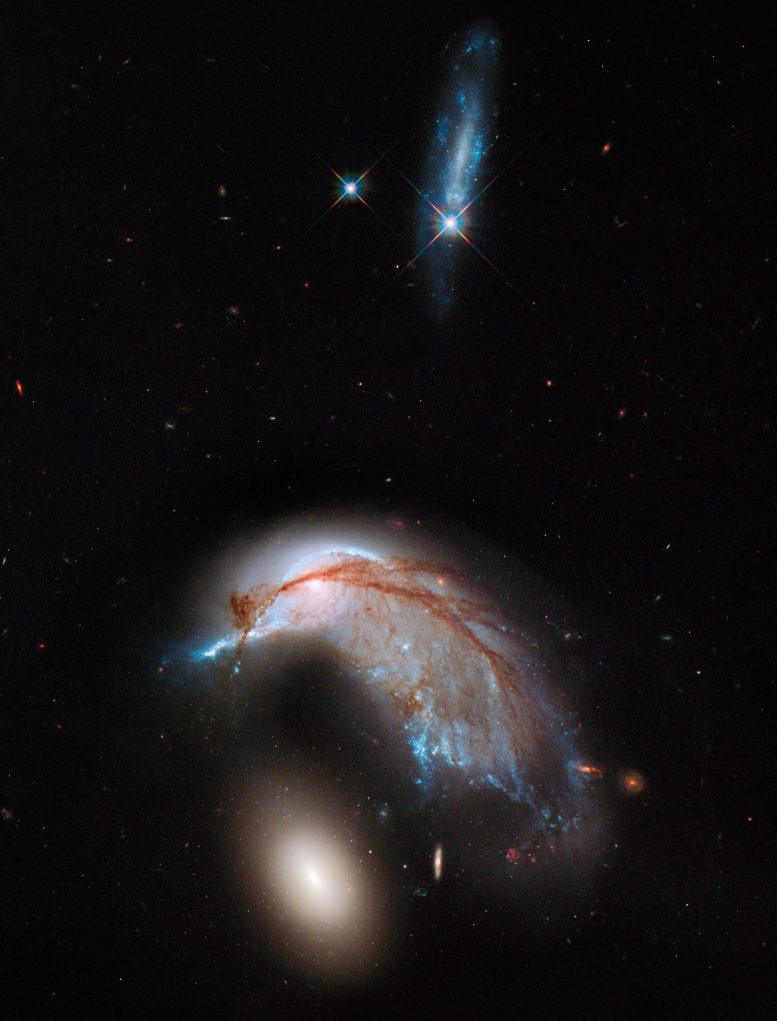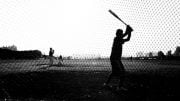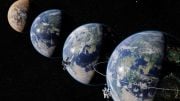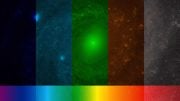
This image shows the two galaxies interacting. NGC 2936, once a standard spiral galaxy, and NGC 2937, a smaller elliptical, bear a striking resemblance to a penguin guarding its egg. This image is a combination of visible and infrared light, created from data gathered by the NASA/ESA Hubble Space Telescope Wide Field Planetary Camera 3 (WFC3).
Credit:
NASA, ESA and the Hubble Heritage Team (STScI/AURA)
This new Hubble Space telescope image shows two interacting galaxies, spiral galaxy NGC 2936 and elliptical galaxy NGC 2937, which are collectively known as Arp 142.
This striking NASA Hubble Space Telescope image, which shows what looks like the profile of a celestial bird, belies the fact that close encounters between galaxies are a messy business.
This interacting galaxy duo is collectively called Arp 142. The pair contains the disturbed, star-forming spiral galaxy NGC 2936, along with its elliptical companion, NGC 2937 at lower left.
This episode of the Hubblecast explores the violent world of galactic mergers, as shown by the cosmic duo Arp 142 in a stunning new image from the NASA/ESA Hubble Space Telescope.
Once part of a flat, spiral disk, the orbits of the galaxy’s stars have become scrambled due to gravitational tidal interactions with the other galaxy. This warps the galaxy’s orderly spiral, and interstellar gas is strewn out into giant tails like stretched taffy.
Gas and dust drawn from the heart of NGC 2936 become compressed during the encounter, which in turn triggers star formation. These bluish knots are visible along the distorted arms that are closest to the companion elliptical. The reddish dust, once within the galaxy, has been thrown out of the galaxy’s plane and into dark veins that are silhouetted against the bright starlight from what is left of the nucleus and disk.
This video shows a 3D visualization of merging galaxy duo Arp 142. Credit: NASA, ESA, and G. Bacon, L. Frattare, Z. Levay, and F. Summers (Viz 3D Team, STScI)
The companion elliptical, NGC 2937, is a puffball of stars with little gas or dust present. The stars contained within the galaxy are mostly old, as evidenced by their reddish color. There are no blue stars that would be evidence of recent star formation. While the orbits of this elliptical’s stars may be altered by the encounter, it’s not apparent that the gravitational pull by its neighboring galaxy is having much of an effect.
This video sequence begins with a zoom through the constellation of Hydra in the night sky, finishing with Hubble observations of Arp 142. Credit: NASA, ESA, and G. Bacon, L. Frattare, Z. Levay, and F. Summers (Viz 3D Team, STScI), Digitized Sky Survey 2
Above the pair, an unrelated, lone, bluish galaxy, inconsistently cataloged as UGC 5130, appears to be an elongated irregular or an edge-on spiral. Located 230 million light-years away, this galaxy is much closer to us than the colliding pair, and therefore is not interacting with them. It happens to lie along the same line of sight to foreground Milky Way stars caught in the image.
This video sequence begins with a zoom through the constellation of Hydra in the night sky, finishing with Hubble observations of Arp 142. These observations then give way to a 3D visualization of the two galaxies. Credit: NASA, ESA, and G. Bacon, L. Frattare, Z. Levay, and F. Summers (Viz 3D Team, STScI), Digitized Sky Survey 2.
Arp 142 lies 326 million light-years away in the southern constellation Hydra. It is a member of the Arp catalog of peculiar galaxies observed by astronomer Halton C. Arp in the 1960s.
This color image is a composite of Wide Field Camera 3 photos taken in visible, red, and infrared light.
This video shows an animation of Hubble, before moving to zoom down through the telescope itself. Hubble is able to capture stunning images, providing an insight into some of the most turbulent events in our Universe. Credit: ESA/Hubble and M. Kornmesser
The Hubble Space Telescope is a project of international cooperation between NASA and the European Space Agency. NASA’s Goddard Space Flight Center in Greenbelt, Md., manages the telescope. The Space Telescope Science Institute (STScI) in Baltimore, Md., conducts Hubble science operations. STScI is operated by the Association of Universities for Research in Astronomy Inc., in Washington.









Be the first to comment on "Hubble Views Interacting Galaxy Duo Arp 142"